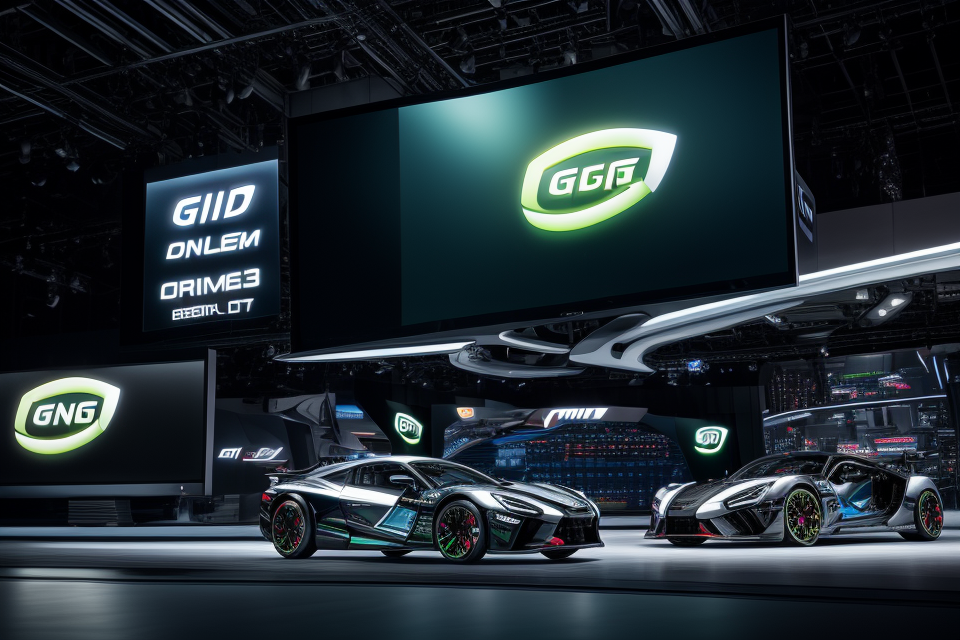
Are you ready to dive into the world of graphics cards and discover what the future holds for GPUs? From gaming to artificial intelligence, graphics cards have become an essential component in modern technology. In this article, we will explore the current state of the GPU market and make predictions for the future. Get ready to learn about the latest trends, innovations, and challenges that will shape the graphics card industry in the coming years. Whether you’re a gamer, a developer, or just a tech enthusiast, this comprehensive market prediction will give you a glimpse into the exciting world of GPUs. So, let’s get started and find out what the future holds for graphics cards!
The future of GPUs looks promising, with advancements in technology driving innovation in the graphics card market. With the increasing demand for realistic graphics in gaming, virtual reality, and other applications, the need for powerful GPUs is on the rise. Additionally, the development of AI and machine learning algorithms has created a demand for GPUs with high processing power. As a result, leading manufacturers such as NVIDIA and AMD are constantly pushing the boundaries of what is possible with their graphics cards, with new releases and upgrades expected in the coming years. The market for GPUs is expected to continue to grow, driven by the need for powerful graphics processing and the growing popularity of cloud-based gaming services. Overall, the future of GPUs looks bright, with exciting developments on the horizon.
GPU Market Overview
The Evolution of Graphics Cards
From 2D to 3D graphics
In the early days of computing, graphics were limited to 2D representations. This changed with the introduction of 3D graphics, which allowed for more realistic and immersive visual experiences. 3D graphics were first used in the gaming industry, but they soon found their way into other fields such as engineering, architecture, and medical imaging.
The rise of gaming and multimedia
As the technology behind 3D graphics improved, so did the demand for more powerful graphics cards. Gaming became a popular pastime, and gamers began to expect increasingly realistic and detailed graphics. In addition to gaming, multimedia applications such as video editing and animation also required more powerful graphics cards to handle the increasingly complex visuals.
The emergence of AI and machine learning
More recently, the demand for powerful graphics cards has been driven by the emergence of artificial intelligence (AI) and machine learning. These technologies require large amounts of data to be processed quickly, and graphics cards are well-suited to this task due to their ability to perform complex calculations in parallel. As a result, graphics cards have become an essential component in many AI and machine learning applications.
Current GPU Market Trends
Market share of major GPU manufacturers
In the current market landscape, there are a few major players that dominate the GPU manufacturing industry. Nvidia and AMD are the two biggest players, with Nvidia holding a larger market share than AMD. This can be attributed to Nvidia’s strong brand recognition, consistent performance, and innovative product offerings. However, AMD has been making significant strides in recent years, with its Radeon series of graphics cards gaining popularity among gamers and professionals alike.
Most popular graphics cards for different segments (gaming, professional, AI)
In the gaming segment, Nvidia’s GeForce series, particularly the GTX and RTX models, remain the most popular choice for gamers. AMD’s Radeon RX series also offers strong competition, particularly in the mid-range segment. For professional use, such as content creation, engineering, and scientific simulations, Nvidia’s Quadro and AMD’s Radeon Pro series are widely used due to their reliability and performance.
In the emerging field of AI, both Nvidia and AMD have developed specialized GPUs specifically designed for AI workloads. Nvidia’s Volta, Turing, and Ampere architectures have been particularly successful in this space, while AMD’s Radeon Instinct series has also gained traction among AI researchers and developers.
Pricing trends and factors affecting the market
The GPU market has experienced significant pricing fluctuations in recent years. Factors such as supply chain disruptions, changes in demand, and cryptocurrency mining have all contributed to the volatility of GPU prices. In particular, the rise of cryptocurrency mining has led to a shortage of graphics cards available for purchase by consumers, driving up prices and making it difficult for some to purchase the graphics cards they need.
As the demand for graphics cards continues to grow, particularly in the gaming and AI sectors, it remains to be seen how the market will evolve in the coming years. However, it is clear that the major GPU manufacturers will continue to innovate and compete in order to meet the demands of their customers.
GPU Technology Advancements
Next-Generation Graphics APIs
The future of GPUs is heavily dependent on the advancements in graphics APIs. The following are some of the key updates expected in the next generation of graphics APIs:
Updates to DirectX and Vulkan
DirectX and Vulkan are two of the most widely used graphics APIs. The next generation of these APIs is expected to bring several new features and improvements, including better support for virtual reality (VR) and augmented reality (AR) technologies, improved performance, and better integration with the latest hardware.
Ray tracing and real-time global illumination
Ray tracing is a technique used to simulate the behavior of light in a scene. The next generation of graphics APIs is expected to bring significant improvements in ray tracing technology, enabling real-time global illumination and more realistic lighting effects in games and other applications.
Support for new display technologies (e.g., VR, AR, 8K)
The next generation of graphics APIs is also expected to bring better support for new display technologies, such as virtual reality (VR), augmented reality (AR), and 8K resolution. This will enable developers to create more immersive experiences and push the boundaries of what is possible with graphics cards.
In conclusion, the next generation of graphics APIs is expected to bring significant improvements and new features to GPUs, enabling better performance, more realistic lighting effects, and support for new display technologies. These advancements will have a major impact on the future of GPUs and the graphics card market.
AI Acceleration
- Tensor cores and deep learning
- Introduction of tensor cores in GPUs
- How tensor cores accelerate deep learning
- Tensor cores in different GPU architectures
- Impact of tensor cores on AI performance
- Inference and training acceleration
- Optimizing AI inference for real-time performance
- GPU training for large-scale AI models
- Hardware acceleration for deep learning frameworks
- Challenges and opportunities in AI acceleration
- AutoML and edge AI
- AutoML and its role in GPU technology
- Moving AI to edge devices with GPUs
- Advantages and limitations of edge AI
- Future developments in AutoML and edge AI
Memory and Bandwidth Innovations
The development of memory and bandwidth technologies in GPUs is a crucial aspect that affects their performance and capabilities. The advancements in this area will have a significant impact on the future of graphics cards. Here are some of the innovations that we can expect to see in the coming years:
- Higher memory capacities and faster speeds: The current GPUs have limited memory capacities and speeds, which can limit their performance in certain tasks. However, the development of more advanced memory technologies is expected to increase memory capacities and speeds. This will enable GPUs to handle more complex tasks and provide better performance.
- Emerging memory technologies: In addition to the traditional GDDR memory, new memory technologies such as High-Bandwidth Memory (HBM) and Magnetic Random Access Memory (MRAM) are being developed. These new technologies promise higher bandwidth, lower power consumption, and better performance than the current memory technologies. As a result, they are expected to become increasingly popular in the future.
- Wider memory interfaces and higher bandwidth: The current GPUs have relatively narrow memory interfaces, which can limit their performance in certain tasks. However, the development of wider memory interfaces and higher bandwidth technologies is expected to increase the memory bandwidth of GPUs. This will enable them to handle more complex tasks and provide better performance.
Overall, the advancements in memory and bandwidth technologies are expected to play a crucial role in the future of GPUs. As these technologies continue to evolve, we can expect to see GPUs with higher performance, lower power consumption, and better capabilities.
GPU Market Growth Opportunities
Emerging Applications
Cloud gaming and virtual desktop infrastructure
As more people are working remotely, the demand for cloud-based solutions is increasing. Cloud gaming and virtual desktop infrastructure (VDI) are two emerging applications that are expected to drive the demand for GPUs in the future. Cloud gaming allows users to play video games on remote servers, rather than on their own computers, and VDI enables users to access their desktop environments from remote locations. Both of these applications require powerful GPUs to deliver a seamless user experience, and this is expected to drive the demand for GPUs in the future.
Metaverse and virtual reality
The metaverse is a virtual world that is being created by a combination of virtual reality (VR), augmented reality (AR), and other technologies. It is expected to be a massive market in the future, and GPUs will play a crucial role in its development. VR and AR applications require powerful GPUs to render realistic images and provide a seamless user experience. As the metaverse continues to grow, the demand for GPUs is expected to increase as well.
Autonomous vehicles and robotics
Autonomous vehicles and robotics are two other emerging applications that are expected to drive the demand for GPUs in the future. Autonomous vehicles require powerful GPUs to process the large amounts of data that are generated by their sensors and cameras. Robotics also require powerful GPUs to process data and perform complex calculations. As these applications become more widespread, the demand for GPUs is expected to increase as well.
Geographical Expansion
Market growth in developing regions
In recent years, the demand for graphics cards has seen significant growth in developing regions such as Asia Pacific, Latin America, and the Middle East. This trend is expected to continue as these regions experience an increase in disposable income and a growing interest in technology. As a result, there is a considerable opportunity for GPU manufacturers to tap into these markets and expand their customer base.
Potential for new markets in emerging industries
The increasing demand for graphics cards is not limited to traditional markets such as gaming and professional computing. Emerging industries such as virtual reality, augmented reality, and artificial intelligence are also driving the demand for more powerful graphics processing capabilities. This presents a significant opportunity for GPU manufacturers to enter new markets and diversify their product offerings.
Challenges and opportunities in different regions
While the potential for growth in developing regions is significant, there are also challenges that must be addressed. These include infrastructure limitations, regulatory hurdles, and competition from local manufacturers. Nevertheless, with the right strategies in place, GPU manufacturers can overcome these challenges and take advantage of the opportunities presented by these markets.
In conclusion, the future of GPUs looks bright, with significant growth opportunities in both traditional and emerging markets. By expanding their reach into developing regions and exploring new markets in emerging industries, GPU manufacturers can continue to drive innovation and growth in the years to come.
GPU as a Service
Cloud-based graphics solutions have become increasingly popular in recent years, as more businesses and individuals turn to remote work and cloud-based services. This trend is expected to continue, with the global cloud market expected to reach $1 trillion by 2024. As a result, there is a growing demand for cloud-based graphics solutions that can provide high-performance graphics capabilities to users across a wide range of industries.
Software-defined graphics acceleration is another area of growth for GPU as a Service. This technology allows businesses to offload graphics processing tasks to the cloud, freeing up resources on their own hardware. This can be particularly beneficial for businesses that need to handle large amounts of data or perform complex graphics processing tasks, as it allows them to scale their graphics processing capabilities up or down as needed.
Hardware-as-a-Service business models are also gaining popularity in the GPU as a Service market. This approach allows businesses to rent GPUs on a monthly basis, rather than purchasing them outright. This can be a cost-effective solution for businesses that need access to high-performance graphics capabilities but do not want to invest in the hardware themselves.
Overall, the GPU as a Service market is expected to experience significant growth in the coming years, driven by the increasing demand for cloud-based graphics solutions and the growing popularity of hardware-as-a-service business models. As a result, businesses that are looking to stay ahead of the curve should consider exploring the potential of GPU as a Service to meet their graphics processing needs.
Challenges and Threats to GPU Market
Competition from Other Accelerators
While graphics processing units (GPUs) have been the go-to accelerators for many computing tasks, they are not the only option available in the market. There are several other accelerators that are competing with GPUs for market share, and these competitors pose significant challenges to the dominance of GPUs. In this section, we will discuss some of the most prominent competitors to GPUs, namely neural processing units (NPUs), field-programmable gate arrays (FPGAs), and application-specific integrated circuits (ASICs).
Neural Processing Units (NPUs)
Neural processing units (NPUs) are specialized processors designed specifically for artificial intelligence (AI) and machine learning (ML) workloads. They are optimized to accelerate deep learning algorithms and are designed to provide high throughput and low latency. NPUs are gaining popularity due to their ability to handle complex AI workloads more efficiently than GPUs.
Some of the leading players in the NPU market include Google, NVIDIA, and Intel. Google’s Tensor Processing Unit (TPU) is a highly specialized NPU that is designed specifically for ML workloads. NVIDIA’s Tensor Core is another example of an NPU that is integrated into its GPUs to accelerate AI workloads. Intel’s Nervana Neural Network Processor (NNP) is a family of NPUs that are designed to provide high performance and scalability for AI workloads.
Field-Programmable Gate Arrays (FPGAs)
Field-programmable gate arrays (FPGAs) are programmable logic devices that can be reconfigured to perform a wide range of tasks. They are highly versatile and can be used for a variety of applications, including video processing, networking, and cryptography. FPGAs are often used as an alternative to GPUs due to their flexibility and ability to provide high performance.
Some of the leading players in the FPGA market include Intel, Xilinx, and Lattice Semiconductor. Intel’s Stratix 10 FPGA is one of the most powerful FPGAs available in the market, with over 2.8 million logic elements and 10 billion transistors. Xilinx’s Virtex UltraScale+ FPGA is another example of a highly capable FPGA that is used in a wide range of applications, including data center, networking, and video processing.
Application-Specific Integrated Circuits (ASICs)
Application-specific integrated circuits (ASICs) are custom-designed chips that are optimized for a specific application. They are designed to provide high performance and low power consumption for a specific task, such as cryptography or video encoding. ASICs are often used as an alternative to GPUs due to their ability to provide high performance at a lower cost.
Some of the leading players in the ASIC market include Bitmain, Canaan, and NVIDIA. Bitmain’s Antminer S17 Pro is an example of an ASIC that is designed specifically for cryptocurrency mining. Canaan’s AvalonMiner 1146 Pro is another example of an ASIC that is optimized for cryptocurrency mining. NVIDIA’s Tesla P40 is an example of an ASIC that is designed for scientific computing and high-performance computing workloads.
In conclusion, GPUs face significant competition from other accelerators such as NPUs, FPGAs, and ASICs. While GPUs have traditionally been the dominant accelerator for many computing tasks, these competitors offer unique advantages that make them attractive alternatives for certain workloads. As the demand for AI and ML workloads continues to grow, it is likely that we will see increased competition between these accelerators, and it remains to be seen which technology will emerge as the dominant accelerator in the future.
Supply Chain and Manufacturing Issues
Challenges in Scaling Production
The graphics card market has seen a significant surge in demand in recent years, particularly with the rise of cryptocurrency mining and the growing popularity of gaming and graphically intensive applications. As a result, manufacturers have struggled to keep up with the demand, leading to a supply shortage and increased prices. The challenges in scaling production include:
- Limited manufacturing capacity: Many graphics card manufacturers have limited manufacturing capacity, which makes it difficult to increase production quickly to meet the growing demand.
- Technological limitations: The production process for graphics cards is highly complex, requiring specialized equipment and skilled labor. As a result, there are technological limitations to how quickly manufacturers can scale production.
- Infrastructure constraints: Manufacturers may face infrastructure constraints, such as limited access to electricity or raw materials, which can also limit their ability to scale production.
Raw Material Shortages and Price Fluctuations
Raw material shortages and price fluctuations can also pose a significant challenge to the graphics card market. Some of the key raw materials used in the production of graphics cards include copper, aluminum, and rare earth minerals such as gallium.
- Copper is used in the wiring and connectors of graphics cards, and a shortage of copper can lead to delays in production and increased costs.
- Aluminum is used in the housing and cooling systems of graphics cards, and a shortage of aluminum can also lead to delays and increased costs.
- Rare earth minerals such as gallium are used in the production of semiconductors, which are a key component of graphics cards. A shortage of these minerals can lead to delays in production and increased costs.
Global Political and Economic Uncertainties
Global political and economic uncertainties can also pose a threat to the graphics card market. The ongoing COVID-19 pandemic has disrupted global supply chains and caused disruptions in the production and distribution of graphics cards.
- The pandemic has led to closures of manufacturing facilities and disruptions in the transportation of raw materials and finished products.
- Political tensions and trade disputes between countries can also disrupt the supply chain and lead to increased costs and delays.
- Economic downturns can lead to decreased demand for graphics cards, which can result in reduced production and increased inventory levels.
Overall, the challenges and threats to the GPU market are significant, and manufacturers will need to navigate these issues carefully to ensure that they can meet the growing demand for graphics cards.
Regulatory and Environmental Concerns
Energy Efficiency and Sustainability
As the demand for more powerful graphics cards continues to rise, the energy consumption of these devices has become a significant concern. The GPU market faces pressure to improve energy efficiency and reduce the environmental impact of their products.
One solution to this problem is the development of more power-efficient graphics processing units (GPUs). Manufacturers are investing in research and development to create GPUs that consume less power while still delivering high performance. This trend is expected to continue as the industry seeks to meet increasingly stringent energy efficiency standards and regulations.
Government Policies and Regulations
Governments around the world are implementing policies and regulations aimed at reducing carbon emissions and promoting sustainable technologies. These policies can have a significant impact on the GPU market, as they may require manufacturers to adopt certain standards or technologies.
For example, some governments are considering bans on the sale of new gasoline-powered cars, which could lead to an increased demand for electric vehicles that rely on GPUs for advanced driver assistance systems and autonomous driving. Additionally, regulations around data centers could impact the GPU market, as these regulations often focus on energy efficiency and sustainability.
Industry Standards and Certifications
The GPU market is also facing pressure to adopt industry standards and certifications related to energy efficiency and sustainability. Organizations such as the Environmental Protection Agency (EPA) and the Green Electronics Council (GEC) are developing standards for environmentally friendly products, including graphics cards.
Manufacturers that comply with these standards may be able to differentiate themselves from competitors and appeal to environmentally conscious consumers. Additionally, these standards may become mandatory in certain markets, further impacting the GPU market.
Overall, regulatory and environmental concerns are shaping the future of the GPU market. As demand for more powerful and efficient graphics cards continues to grow, manufacturers will need to address these concerns in order to remain competitive and meet the needs of consumers and governments around the world.
FAQs
1. What is a GPU?
A GPU, or Graphics Processing Unit, is a specialized type of processor designed specifically for handling the complex calculations required to render images and video. GPUs are commonly used in computers for gaming, professional visualization, and machine learning applications.
2. What is the current state of the GPU market?
The GPU market is currently experiencing strong growth, driven by the increasing demand for graphics cards in gaming, professional visualization, and machine learning applications. The market is also being driven by the increasing popularity of cryptocurrencies, which require specialized graphics cards for mining.
3. What factors are driving the growth of the GPU market?
There are several factors driving the growth of the GPU market, including the increasing popularity of gaming and virtual reality, the growing use of graphics cards in professional applications such as engineering and architecture, and the increasing demand for machine learning and artificial intelligence.
4. What is the future outlook for the GPU market?
The future outlook for the GPU market is positive, with analysts predicting continued growth in demand for graphics cards in a variety of applications. The market is expected to be driven by the increasing use of graphics cards in emerging technologies such as autonomous vehicles, virtual reality, and artificial intelligence.
5. What are some of the challenges facing the GPU market?
Some of the challenges facing the GPU market include the high cost of graphics cards, which can make them prohibitively expensive for some consumers, and the limited availability of certain models due to supply chain issues. Additionally, the market is highly competitive, with many manufacturers vying for market share.
6. How does the GPU market differ regionally?
The GPU market can differ regionally due to a variety of factors, including cultural differences in gaming and entertainment preferences, the availability and cost of electricity for mining operations, and government regulations and policies.
7. What types of graphics cards are available in the market?
There are several types of graphics cards available in the market, including consumer-grade cards for gaming and entertainment, professional-grade cards for use in professional visualization and machine learning applications, and specialized mining cards designed specifically for cryptocurrency mining.
8. How do I choose the right graphics card for my needs?
Choosing the right graphics card for your needs depends on a variety of factors, including the specific applications you will be using the card for, your budget, and your technical expertise. It is important to research and compare different models to find the one that best meets your needs.


